Dental Library – Emergency Closure 8/4/16
The Dental Library is currently closed due to a power outage. The Library plans on reopening tomorrow morning at 8am.
The Dental Library is currently closed due to a power outage. The Library plans on reopening tomorrow morning at 8am.
Both the Dental and Isché Libraries will be closed Saturday – Monday, July 2-4 in observance of the Independence Day holiday. The Isché Library will close at 8pm on Friday, July 1st and the Dental Library will close at 5pm. Both Libraries will reopen on Tuesday, July 5th at 8am.
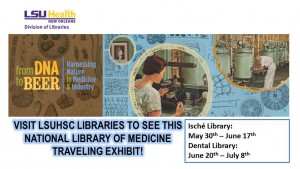
The National Library of Medicine’s traveling exhibit “From DNA to Beer: Harnessing Nature in Medicine and Industry” is now at the LSU School of Dentistry Library! Come explore the history of biotechnology, and peruse our selection of related books and articles. The Dental Library is located on the third floor of the Administration Building, and the exhibit will be there from June 20th-July 8th.
This exhibition was developed and produced by the National Library of Medicine, National Institutes of Health and the Smithsonian’s National Museum of American History. Additional information about this exhibit can be found online: https://www.nlm.nih.gov/hmd/about/exhibition/fromdnatobeer.html.
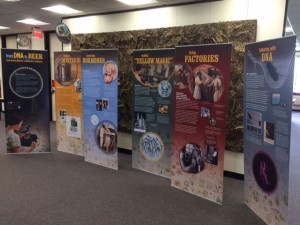
NLM display at Dental Library
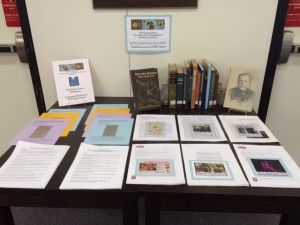
Supplemental Materials Display
MICROBES—tiny organisms too small to be seen with the naked eye—have altered human history. Life forms such as bacteria, yeasts, and molds can cause sickness or restore health, and help produce foods and beverages.
Scientists, in partnership with industry, have developed techniques to harness the powers of these microbes. In recent years, headline-grabbing technologies have used genetically modified bacteria to manufacture new medicines.
A glimpse into the past reveals a history of human enterprise that has adapted these tiny organisms for health and profit. This exhibition explores some of the processes, problems, and potential inherent in technologies that use life.
The Dental Library has now designated two weekdays for 3D printing jobs: Wednesday and Friday.
We understand that the noise generated by the 3D printer can be distracting. At the same time, we want this technology to be openly available and conveniently usable for all students and faculty. As a compromise, we will restrict 3D printing to Wednesdays and Fridays so everyone will be guaranteed quality time in the library.
It should be noted that we may not always have 3D print projects going on the designated days; likewise, we may have to start a priority project on an off day. So please bear with us as we try to provide an accessible educational space for everyone to study, learn, and discover.
Come try out our 3D printer on Wednesdays and Fridays!

Both the Dental and Isché Libraries will close early on Thursday, March 24th and remain closed Friday, March 25th through Sunday, March 27th. The Dental Library will close at 5 pm and the Isché Library will close at 8 pm.
Both Libraries will reopen on Monday, March 28th at 8 am.
Due to a scheduled power outage on the Dental Campus, the Dental Library will be closed on Sunday, March 20th. There will no power to either buildings and no one will be allowed on campus from 7:00 AM – 4:00PM.
The LSUHSC campuses are closed today, Friday, March 11, 2016 due to the wind & rain. Only essential personnel should be on campus.
The Isché Library will reopen on Saturday, March 12th at 9:30 am. The Dental Library will reopen on Sunday, March 13th at 11 am.
The Dental Library will close tomorrow evening at 5:30pm due to a scheduled power outage on the Dental Campus. There will no power to either buildings and no one will be allowed on campus from 6:00 – 8:00pm.
Both Libraries will have shorter hours over Mardi Gras weekend/week. They are as follows:
The Isché Library will close at 6pm on Friday, February 5th and will be open from 9:30am -3pm on Saturday, February 6th. On Sunday, February 7th, it will be open from 12noon to 5pm.
Both Libraries will close at 5pm on Monday, February 8th and will be closed on Tuesday, February 9th.
The Dental Library will close at 5pm Wednesday and Thursday, February 10th and 11th.
All other dates the Libraries will be open their regular hours.
The Dental Library will close this evening at 5pm because of emergency water repairs on the Dental Campus. There will be a complete water shutdown beginning at 5pm to repair a broken water main.
Both the Dental and Isché Libraries will be closed on Monday, January 18th in honor of the Martin Luther King, Jr Day Holiday. Both Libraries will be open their regular hours on Sunday the 17th (11:30 am to 8 pm for Dental and 12 noon to 12 midnight for Isché) and on Tuesday the 19th (8 am to 8 pm for Dental and 8 am to 12 midnight for Isché).
Both the Isché and Dental Libraries have reopened from Winter Break!
Happy 2016 everyone
Both the Dental and Isché Libraries are both closed for winter break. The Libraries will reopen at 8am on Monday, January 4th and resume normal hours.
Online resources will, of course, be available 24/7 during this time.
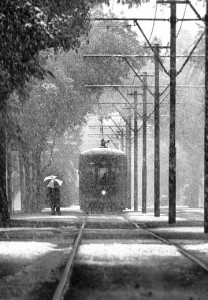 The Libraries are now on Winter Break hours.
The Libraries are now on Winter Break hours.
| Dental | Isché | |||
| Friday, December 18th | 8am – 5pm | 8am – 6pm | ||
| Saturday, December 19th | closed | 9:30am – 6pm | ||
| Sunday, December 20th | 11:30am – 8pm | 12noon – 8:30pm | ||
| Monday, December 21st-Wednesday, December 23rd | 8am – 5pm | 8am – 6pm | ||
| Thursday, December 24th-Sunday, January 3rd | closed | closed |
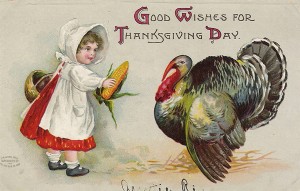 The Libraries will both close early on Wednesday, November 25th; the Dental Library will close at 5 pm and the Isché Library will close at 6 pm. Both Libraries will remain closed from Thursday, November 26th through Saturday, November 28th.
The Libraries will both close early on Wednesday, November 25th; the Dental Library will close at 5 pm and the Isché Library will close at 6 pm. Both Libraries will remain closed from Thursday, November 26th through Saturday, November 28th.
The Dental Library will be open its regular hours on Sunday, November 29th from 11:30 am to 8 pm.
The Isché Library will be open for exam hours on Sunday, November 29th from 12 noon to 12 midnight. Exam hours will continue through Thursday, December 17th.
For the complete schedule for both Libraries, consult our webpage.